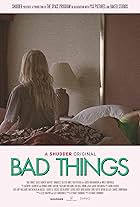At its core, the film is a haunting look into the mind of a despairing artist. As the artist is scorned by his audience and his colleagues alike, he returns to his childhood home, only to find his mother dying of some respiratory disease, and his presence replaced by a man adopted from a mental institution. Slowly he succumbs to his neurosis, ailed by paranoia and scrabbling for control of his life. Ultimately, he must make the choice whether or not to force his way back into his childhood home, or leave quietly and face the outside world.
Director Subbotko has an auteur's keen eye when it comes to mise-en-scene, making sure to control every aspect of the visuals very carefully. The movement of the camera is masterful, and subtly draws the audience inwards towards the world. The colors and tone are painterly, and Subbotko isn't afraid to let the awkwardness of real life leak into the film.
The music, in particular, is a look both into the main character's and Subbotko's mind. A simple orchestral riff from Polish Composer Szymanowski, repeated numerous times throughout the film, marks the limits between reality and the main character's paranoia. Though hauntingly beautiful, its appearance changes the tone of the scene entirely with every appearance. By the end of the film, it seems to be a harbinger of ruin. It is an elegant use of music, simple in execution, but impactful in delivery.
However strong the thematic and cinematic delivery of the film is, it ultimately falls a bit short on the delivery of the film's central story. The issue is not the film chooses to be ambiguous in its exposition, or that the ending raises more questions than it answers, but rather from the beginning of the film to its very end, there seems to be a lacking driving force behind the main character. There is no push behind him - he seems to do things absolutely on a whim, decisions made without logic in mind. In the end, the viewer might be left thinking, "I may have just experienced something incredibly profound. I'm not exactly sure what about it is profound, or if I really have anything to say about it, other than wanting to ask the main character: Why!?"
However, the fact that the film is as headless as it is tailless, may not be that much of an issue. A film that can leave an audience muttering about it quietly long into the credits is the mark of a film that has left an impact on its audience, and ultimately, that's more than a lot of films can say nowadays.




























